Science
Elephant seals drift off to sleep while diving far below the ocean surface
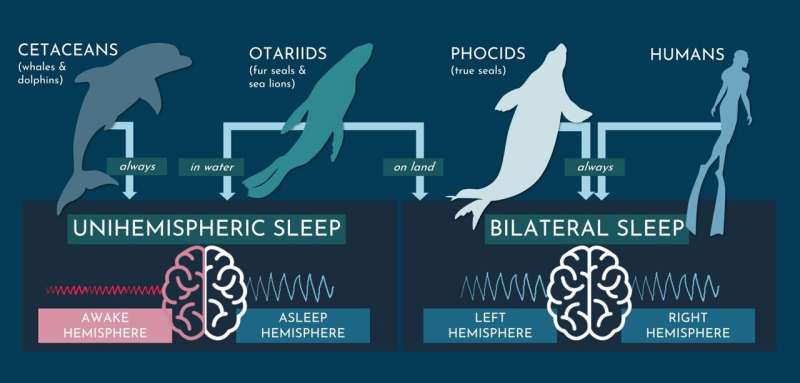
|
|
For the first time, scientists have recorded brain activity in a free-ranging, wild marine mammal, revealing the sleep habits of elephant seals during the months they spend at sea.
The new findings, published April 20 in Science, show that while elephant seals may spend 10 hours a day sleeping on the beach during the breeding season, they average just 2 hours of sleep per day when they are at sea on months-long foraging trips. They sleep for about 10 minutes at a time during deep, 30-minute dives, often spiraling downward while fast asleep, and sometimes lying motionless on the seafloor.
First author Jessica Kendall-Bar led the study as a UC Santa Cruz graduate student working with Daniel Costa and Terrie Williams, both professors of ecology and evolutionary biology at UCSC.
“For years, one of the central questions about elephant seals has been when do they sleep,” said Costa, who directs UCSC’s Institute of Marine Sciences. Costa’s lab has led the UCSC elephant seal research program at Año Nuevo Reserve for over 25 years, using increasingly sophisticated tags to track the movements and diving behavior of the seals during their foraging migrations, when they head out into the North Pacific Ocean for as long as eight months.
“The dive records show that they are constantly diving, so we thought they must be sleeping during what we call drift dives, when they stop swimming and slowly sink, but we really didn’t know,” Costa said. “Now we’re finally able to say they’re definitely sleeping during those dives, and we also found that they’re not sleeping very much overall compared to other mammals.”
In fact, during their months at sea, elephant seals rival the record for the least sleep among all mammals, currently held by African elephants, which appear to sleep just two hours per day based on their movement patterns.
“Elephant seals are unusual in that they switch between getting a lot of sleep when they’re on land, over 10 hours a day, and two hours or less when they’re at sea,” said Kendall-Bar, who is currently a postdoctoral fellow at UC San Diego’s Scripps Institution of Oceanography.
Elephant seals are most vulnerable to predators such as sharks and killer whales when they are at the surface in the open ocean, so they only spend a minute or two breathing at the surface in between dives.
“They’re able to hold their breath for a long time, so they can go into a deep slumber on these dives deep below the surface where it’s safe,” Kendall-Bar said.
Kendall-Bar developed a system that can reliably record brain activity (as an electroencephalogram or EEG) in wild elephant seals during their normal diving behavior at sea. With a neoprene headcap to secure the EEG sensors and a small data logger to record the signals, the system can be recovered when the animals return to the beach at Año Nuevo.
“We used the same sensors you’d use for a human sleep study at a sleep clinic and a removable, flexible adhesive to attach the headcap so that water couldn’t get in and disrupt the signals,” Kendall-Bar said.
In addition to the EEG system, the seals carried time-depth recorders, accelerometers, and other instruments that allowed the researchers to track the seals’ movements along with the corresponding brain activity. The recordings show diving seals going into the deep sleep stage known as slow-wave sleep while maintaining a controlled glide downward, then transitioning into rapid-eye-movement (REM) sleep, when sleep paralysis causes them to turn upside down and drift downwards in a “sleep spiral.”
“They go into slow-wave sleep and maintain their body posture for several minutes before they transition into REM sleep, when they lose postural control and turn upside down,” Kendall-Bar said.
At the depths at which this happens, the seals are usually negatively buoyant and continue to fall passively in a corkscrew spiral “like a falling leaf,” Williams said. In shallower waters over the continental shelf, elephant seals sometimes sleep while resting on the seafloor.
“It doesn’t seem possible that they would truly go into paralytic REM sleep during a dive, but it tells us something about the decision-making processes of these seals to see where in the water column they feel safe enough to go to sleep,” said Williams, who directs the Comparative Neurophysiology Lab at UCSC.
In developing the new EEG instrument, Kendall-Bar first deployed it on elephant seals housed temporarily in the marine mammal facilities at UCSC’s Long Marine Laboratory. The next step was to deploy it on animals in the elephant seal colony at Año Nuevo Reserve north of Santa Cruz, where researchers could observe the animals on the beach.


“I spent a lot of time watching sleeping seals,” Kendall-Bar said. “Our team monitored instrumented seals to make sure they were able to reintegrate with the colony and were behaving naturally.”
Some of those seals took short excursions into the water, but to observe diving behavior the researchers used a translocation procedure developed by Costa’s lab. Juvenile female elephant seals outfitted with the EEG sensors and trackers were transported from Año Nuevo to Monterey and released on a beach at the southern end of Monterey Bay. Over the next few days, the animals would swim back to Año Nuevo across the deep Monterey Canyon, where their dive behavior is very similar to that seen during much longer foraging trips in the open ocean.
With data on brain activity and dive behavior from 13 juvenile female elephant seals, including a total of 104 sleep dives, Kendall-Bar developed a highly accurate algorithm for identifying periods of sleep based on the dive data alone. This enabled her to estimate sleep quotas for 334 adult seals using dive data recorded over several months during their foraging trips.
“Because of the dataset that Dan Costa has curated over 25 years of working with elephant seals at Año Nuevo, I was able to extrapolate our results to over 300 animals and get a population-level look at sleep behavior,” said Kendall-Bar, who now plans to use similar methods to study brain activity in other species of seals and sea lions and in human freedivers.
Williams called Kendall-Bar’s work on the project a tour de force. “It’s an amazing feat to pull this off,” she said. “She developed an EEG system to work on an animal that’s diving several hundred meters in the ocean. Then she uses the data to create data-driven animations so we can really visualize what the animal is doing as it dives through the water column.”
The results may be helpful for conservation efforts by revealing a “sleepscape” of preferred resting areas, Williams said. “Normally, we’re concerned about protecting the areas where animals go to feed, but perhaps the places where they sleep are as important as any other critical habitat,” she said.
More information:
Jessica M. Kendall-Bar, Brain activity of diving seals reveals short sleep cycles at depth, Science (2023). DOI: 10.1126/science.adf0566. www.science.org/doi/10.1126/science.adf0566
Provided by
University of California – Santa Cruz
Citation:
Elephant seals drift off to sleep while diving far below the ocean surface (2023, April 20)
retrieved 21 April 2023
from https://phys.org/news/2023-04-elephant-drift-ocean-surface.html
This document is subject to copyright. Apart from any fair dealing for the purpose of private study or research, no
part may be reproduced without the written permission. The content is provided for information purposes only.





Science
"Hi, It's Me": NASA's Voyager 1 Phones Home From 15 Billion Miles Away – NDTV


<!–
Launched in 1977, Voyager 1 was mankind’s first spacecraft to enter the interstellar medium
Washington, United States:
NASA’s Voyager 1 probe — the most distant man-made object in the universe — is returning usable information to ground control following months of spouting gibberish, the US space agency announced Monday.
The spaceship stopped sending readable data back to Earth on November 14, 2023, even though controllers could tell it was still receiving their commands.
In March, teams working at NASA’s Jet Propulsion Laboratory discovered that a single malfunctioning chip was to blame, and devised a clever coding fix that worked within the tight memory constraints of its 46-year-old computer system.
window._rrCode = window._rrCode || [];_rrCode.push(function() (function(v,d,o,ai)ai=d.createElement(“script”);ai.defer=true;ai.async=true;ai.src=v.location.protocol+o;d.head.appendChild(ai);)(window, document, “//a.vdo.ai/core/v-ndtv/vdo.ai.js”); );
“Voyager 1 spacecraft is returning usable data about the health and status of its onboard engineering systems,” the agency said.
Hi, it’s me. – V1 https://t.co/jgGFBfxIOe
— NASA Voyager (@NASAVoyager) April 22, 2024
“The next step is to enable the spacecraft to begin returning science data again.”
Launched in 1977, Voyager 1 was mankind’s first spacecraft to enter the interstellar medium, in 2012, and is currently more than 15 billion miles from Earth. Messages sent from Earth take about 22.5 hours to reach the spacecraft.
Its twin, Voyager 2, also left the solar system in 2018.
Both Voyager spacecraft carry “Golden Records” — 12-inch, gold-plated copper disks intended to convey the story of our world to extraterrestrials.
These include a map of our solar system, a piece of uranium that serves as a radioactive clock allowing recipients to date the spaceship’s launch, and symbolic instructions that convey how to play the record.
The contents of the record, selected for NASA by a committee chaired by legendary astronomer Carl Sagan, include encoded images of life on Earth, as well as music and sounds that can be played using an included stylus.
window._rrCode = window._rrCode || [];_rrCode.push(function(){ (function(d,t) var s=d.createElement(t); var s1=d.createElement(t); if (d.getElementById(‘jsw-init’)) return; s.setAttribute(‘id’,’jsw-init’); s.setAttribute(‘src’,’https://www.jiosaavn.com/embed/_s/embed.js?ver=’+Date.now()); s.onload=function()document.getElementById(‘jads’).style.display=’block’;s1.appendChild(d.createTextNode(‘JioSaavnEmbedWidget.init(a:”1″, q:”1″, embed_src:”https://www.jiosaavn.com/embed/playlist/85481065″,”dfp_medium” : “1”,partner_id: “ndtv”);’));d.body.appendChild(s1);; if (document.readyState === ‘complete’) d.body.appendChild(s); else if (document.readyState === ‘loading’) var interval = setInterval(function() if(document.readyState === ‘complete’) d.body.appendChild(s); clearInterval(interval); , 100); else window.onload = function() d.body.appendChild(s); ; )(document,’script’); });
Their power banks are expected to be depleted sometime after 2025. They will then continue to wander the Milky Way, potentially for eternity, in silence.
(Except for the headline, this story has not been edited by NDTV staff and is published from a syndicated feed.)
Science
West Antarctica's ice sheet was smaller thousands of years ago – here's why this matters today – The Conversation


As the climate warms and Antarctica’s glaciers and ice sheets melt, the resulting rise in sea level has the potential to displace hundreds of millions of people around the world by the end of this century.
A key uncertainty in how much and how fast the seas will rise lies in whether currently “stable” parts of the West Antarctic Ice Sheet can become “unstable”.
One such region is West Antarctica’s Siple Coast, where rivers of ice flow off the continent and drain into the ocean.
Journal of Geophysical Research, CC BY-SA
This ice flow is slowed down by the Ross Ice Shelf, a floating mass of ice nearly the size of Spain, which holds back the land-based ice. Compared to other ice shelves in West Antarctica, the Ross Ice Shelf has little melting at its base because the ocean below it is very cold.
Although this region has been stable during the past few decades, recent research suggest this was not always the case. Radiocarbon dating of sediments from beneath the ice sheet tells us that it retreated hundreds of kilometres some 7,000 years ago, and then advanced again to its present position within the last 2,000 years.
Figuring out why this happened can help us better predict how the ice sheet will change in the future. In our new research, we test two main hypotheses.
Read more:
What an ocean hidden under Antarctic ice reveals about our planet’s future climate
Testing scenarios
Scientists have considered two possible explanations for this past ice sheet retreat and advance. The first is related to Earth’s crust below the ice sheet.
As an ice sheet shrinks, the change in ice mass causes the Earth’s crust to slowly uplift in response. At the same time, and counterintuitively, the sea level drops near the ice because of a weakening of the gravitational attraction between the ice sheet and the ocean water.
As the ice sheet thinned and retreated since the last ice age, crustal uplift and the fall in sea level in the region may have re-grounded floating ice, causing ice sheet advance.
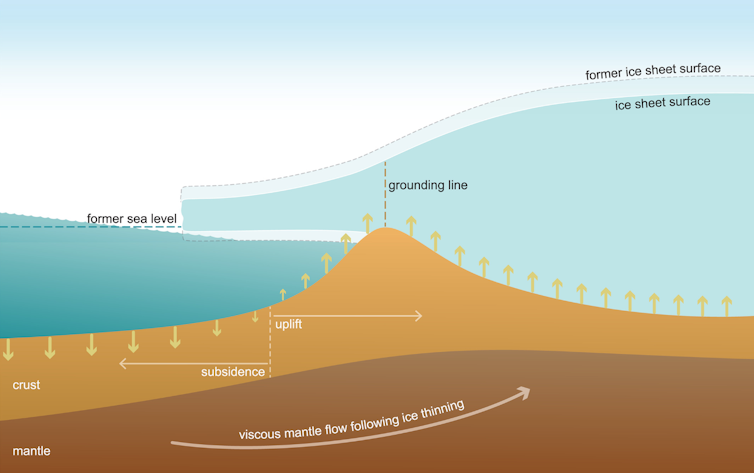
AGU, CC BY-SA
The other hypothesis is that the ice sheet behaviour may be due to changes in the ocean. When the surface of the ocean freezes, forming sea ice, it expels salt into the water layers below. This cold briny water is heavier and mixes deep into the ocean, including under the Ross Ice Shelf. This blocks warm ocean currents from melting the ice.
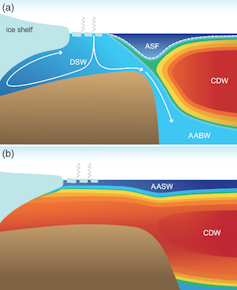
AGU, CC BY-SA
Seafloor sediments and ice cores tell us that this deep mixing was weaker in the past when the ice sheet was retreating. This means that warm ocean currents may have flowed underneath the ice shelf and melted the ice. Mixing increased when the ice sheet was advancing.
We test these two ideas with computer model simulations of ice sheet flow and Earth’s crustal and sea surface responses to changes in the ice sheet with varying ocean temperature.
Because the rate of crustal uplift depends on the viscosity (stickiness) of the underlying mantle, we ran simulations within ranges estimated for West Antarctica. A stickier mantle means slower crustal uplift as the ice sheet thins.
The simulations that best matched geological records had a stickier mantle and a warmer ocean as the ice sheet retreated. In these simulations, the ice sheet retreats more quickly as the ocean warms.
When the ocean cools, the simulated ice sheet readvances to its present-day position. This means that changes in ocean temperature best explain the past ice sheet behaviour, but the rate of crustal uplift also affects how sensitive the ice sheet is to the ocean.
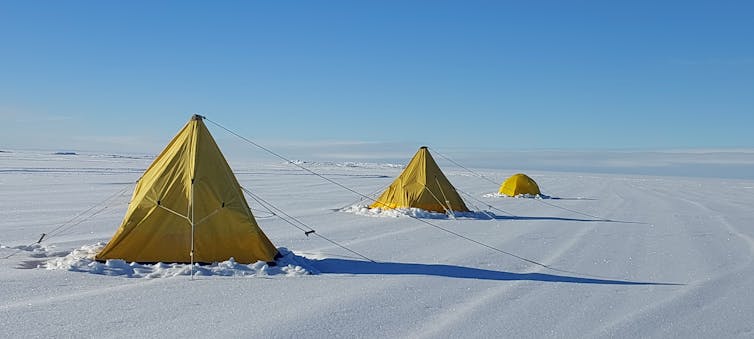
Veronika Meduna, CC BY-SA
What this means for climate policy today
Much attention has been paid to recent studies that show glacial melting may be irreversible in some parts of West Antarctica, such as the Amundsen Sea embayment.
In the context of such studies, policy debates hinge on whether we should focus on adapting to rising seas rather than cutting greenhouse gas emissions. If the ice sheet is already melting, are we too late for mitigation?
Our study suggests it is premature to give up on mitigation.
Global climate models run under high-emissions scenarios show less sea ice formation and deep ocean mixing. This could lead to the same cold-to-warm ocean switch that caused extensive ice sheet retreat thousands of years ago.
For West Antarctica’s Siple Coast, it is better if we prevent this ocean warming from occurring in the first place, which is still possible if we choose a low-emissions future.
Science
NASA's Voyager 1 resumes sending engineering updates to Earth – Phys.org
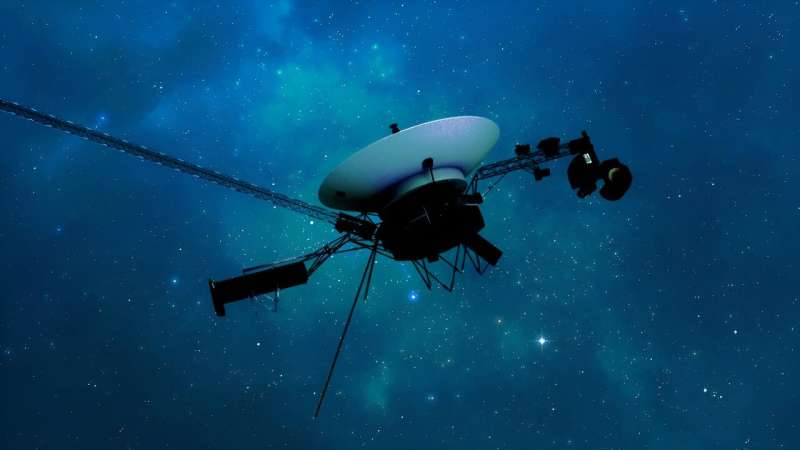

For the first time since November, NASA’s Voyager 1 spacecraft is returning usable data about the health and status of its onboard engineering systems. The next step is to enable the spacecraft to begin returning science data again. The probe and its twin, Voyager 2, are the only spacecraft to ever fly in interstellar space (the space between stars).
Voyager 1 stopped sending readable science and engineering data back to Earth on Nov. 14, 2023, even though mission controllers could tell the spacecraft was still receiving their commands and otherwise operating normally. In March, the Voyager engineering team at NASA’s Jet Propulsion Laboratory in Southern California confirmed that the issue was tied to one of the spacecraft’s three onboard computers, called the flight data subsystem (FDS). The FDS is responsible for packaging the science and engineering data before it’s sent to Earth.
The team discovered that a single chip responsible for storing a portion of the FDS memory—including some of the FDS computer’s software code—isn’t working. The loss of that code rendered the science and engineering data unusable. Unable to repair the chip, the team decided to place the affected code elsewhere in the FDS memory. But no single location is large enough to hold the section of code in its entirety.
So they devised a plan to divide affected the code into sections and store those sections in different places in the FDS. To make this plan work, they also needed to adjust those code sections to ensure, for example, that they all still function as a whole. Any references to the location of that code in other parts of the FDS memory needed to be updated as well.


The team started by singling out the code responsible for packaging the spacecraft’s engineering data. They sent it to its new location in the FDS memory on April 18. A radio signal takes about 22.5 hours to reach Voyager 1, which is over 15 billion miles (24 billion kilometers) from Earth, and another 22.5 hours for a signal to come back to Earth. When the mission flight team heard back from the spacecraft on April 20, they saw that the modification had worked: For the first time in five months, they have been able to check the health and status of the spacecraft.
During the coming weeks, the team will relocate and adjust the other affected portions of the FDS software. These include the portions that will start returning science data.
Voyager 2 continues to operate normally. Launched over 46 years ago, the twin Voyager spacecraft are the longest-running and most distant spacecraft in history. Before the start of their interstellar exploration, both probes flew by Saturn and Jupiter, and Voyager 2 flew by Uranus and Neptune.
Provided by
NASA
Citation:
NASA’s Voyager 1 resumes sending engineering updates to Earth (2024, April 22)
retrieved 22 April 2024
from https://phys.org/news/2024-04-nasa-voyager-resumes-earth.html
This document is subject to copyright. Apart from any fair dealing for the purpose of private study or research, no
part may be reproduced without the written permission. The content is provided for information purposes only.
-
Business17 hours ago
Honda to build electric vehicles and battery plant in Ontario, sources say – Global News
-



 Science17 hours ago
Science17 hours agoWill We Know if TRAPPIST-1e has Life? – Universe Today
-
Investment20 hours ago
Down 80%, Is Carnival Stock a Once-in-a-Generation Investment Opportunity?
-



 Health14 hours ago
Health14 hours agoSee how chicken farmers are trying to stop the spread of bird flu – Fox 46 Charlotte
-



 Health17 hours ago
Health17 hours agoSimcoe-Muskoka health unit urges residents to get immunized
-
News22 hours ago
Honda expected to announce multi-billion dollar deal to assemble EVs in Ontario
-



 Investment15 hours ago
Investment15 hours agoOwn a cottage or investment property? Here's how to navigate the new capital gains tax changes – The Globe and Mail
-



 Science22 hours ago
Science22 hours agoWatch The World’s First Flying Canoe Take Off






